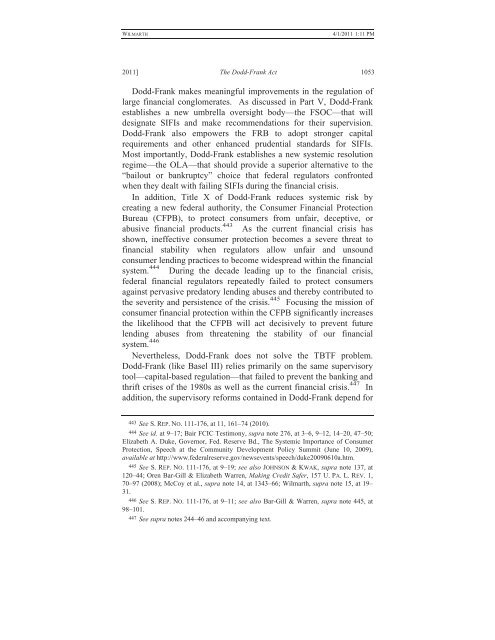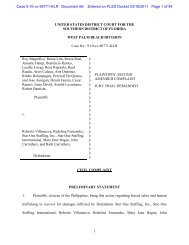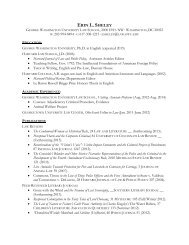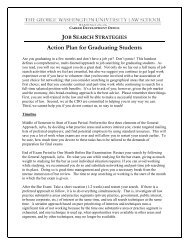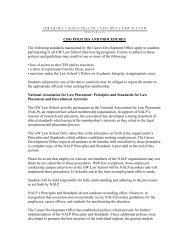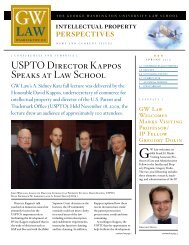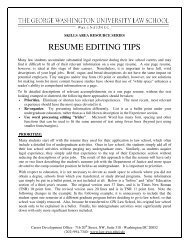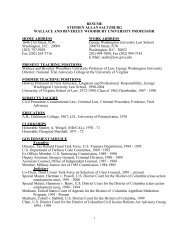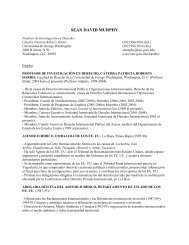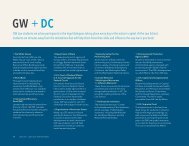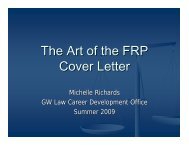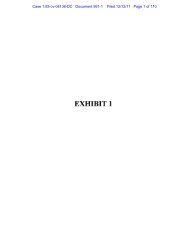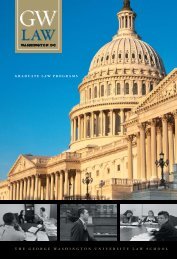CLE Materials for Panel #1 - George Washington University Law ...
CLE Materials for Panel #1 - George Washington University Law ...
CLE Materials for Panel #1 - George Washington University Law ...
Create successful ePaper yourself
Turn your PDF publications into a flip-book with our unique Google optimized e-Paper software.
WILMARTH<br />
4/1/2011 1:11 PM<br />
2011] The Dodd-Frank Act 1053<br />
Dodd-Frank makes meaningful improvements in the regulation of<br />
large financial conglomerates. As discussed in Part V, Dodd-Frank<br />
establishes a new umbrella oversight body—the FSOC—that will<br />
designate SIFIs and make recommendations <strong>for</strong> their supervision.<br />
Dodd-Frank also empowers the FRB to adopt stronger capital<br />
requirements and other enhanced prudential standards <strong>for</strong> SIFIs.<br />
Most importantly, Dodd-Frank establishes a new systemic resolution<br />
regime—the OLA—that should provide a superior alternative to the<br />
“bailout or bankruptcy” choice that federal regulators confronted<br />
when they dealt with failing SIFIs during the financial crisis.<br />
In addition, Title X of Dodd-Frank reduces systemic risk by<br />
creating a new federal authority, the Consumer Financial Protection<br />
Bureau (CFPB), to protect consumers from unfair, deceptive, or<br />
abusive financial products. 443 As the current financial crisis has<br />
shown, ineffective consumer protection becomes a severe threat to<br />
financial stability when regulators allow unfair and unsound<br />
consumer lending practices to become widespread within the financial<br />
system. 444 During the decade leading up to the financial crisis,<br />
federal financial regulators repeatedly failed to protect consumers<br />
against pervasive predatory lending abuses and thereby contributed to<br />
the severity and persistence of the crisis. 445 Focusing the mission of<br />
consumer financial protection within the CFPB significantly increases<br />
the likelihood that the CFPB will act decisively to prevent future<br />
lending abuses from threatening the stability of our financial<br />
system. 446<br />
Nevertheless, Dodd-Frank does not solve the TBTF problem.<br />
Dodd-Frank (like Basel III) relies primarily on the same supervisory<br />
tool—capital-based regulation—that failed to prevent the banking and<br />
thrift crises of the 1980s as well as the current financial crisis. 447 In<br />
addition, the supervisory re<strong>for</strong>ms contained in Dodd-Frank depend <strong>for</strong><br />
443 See S. REP.NO. 111-176, at 11, 161–74 (2010).<br />
444 See id. at 9–17; Bair FCIC Testimony, supra note 276, at 3–6, 9–12, 14–20, 47–50;<br />
Elizabeth A. Duke, Governor, Fed. Reserve Bd., The Systemic Importance of Consumer<br />
Protection, Speech at the Community Development Policy Summit (June 10, 2009),<br />
available at http://www.federalreserve.gov/newsevents/speech/duke20090610a.htm.<br />
445 See S. REP. NO. 111-176, at 9–19; see also JOHNSON & KWAK, supra note 137, at<br />
120–44; Oren Bar-Gill & Elizabeth Warren, Making Credit Safer, 157 U. PA. L.REV. 1,<br />
70–97 (2008); McCoy et al., supra note 14, at 1343–66; Wilmarth, supra note 15, at 19–<br />
31.<br />
446 See S. REP. NO. 111-176, at 9–11; see also Bar-Gill & Warren, supra note 445, at<br />
98–101.<br />
447 See supra notes 244–46 and accompanying text.


